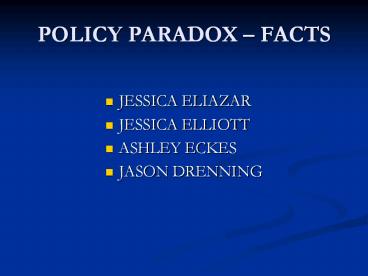POLICY PARADOX - PowerPoint PPT Presentation
Title:
POLICY PARADOX
Description:
'I DON'T KNOW WHICH PART OF THE PARTY IS GOING TO BE MORE INFLUENTIAL OR ... Democratic ... Rational Democratic Model. Reason is the basis for personal and ... – PowerPoint PPT presentation
Number of Views:187
Avg rating:3.0/5.0
Title: POLICY PARADOX
1
POLICY PARADOX FACTS
- JESSICA ELIAZAR
- JESSICA ELLIOTT
- ASHLEY ECKES
- JASON DRENNING
2
Everyone is entitled to their own opinions, but
not their own facts. - Sen. Daniel Patrick
Moynihan (Dem NY)
3
Lecture Outline
- Two Faces of Persuasion
- Rational Democratic Model
- Totalitarian Model
- Polis Model
4
Rational Ideal Face 1
- Persuasion
- Coordinates/Controls Human Behavior
- Rational Decisions
- Frowns Upon Raw Emotion/Passion
5
SQUISH MCCAIN ??
"I DON'T KNOW WHICH PART OF THE PARTY IS GOING TO
BE MORE INFLUENTIAL OR NOT," MCCAIN SAID. "I'VE
TRIED ALWAYS IN MY POLITICAL CAREER TO HAVE A BIG
TENT PARTY WHERE A LOT OF PEOPLE ARE WELCOME WITH
DIFFERING VIEWS."
6
Government The Rational Ideal
- Reason as Basis for Government
- Education Creates Equality
- Conflict Resolution
- Policy Ideas
7
Persuasion or Propaganda?
- "WE SEE AL QAEDA GAINING STRENGTH,"
- "WE SEE AFGHANISTAN SLIDING BACK INTO CHAOS."
8
Propaganda Face 2
- Intentionally Manipulative
- Robs People from Independent Thinking
- Where Should the Line be Drawn?
- When Does Information Cross the Line?
9
Rational Democratic Model
- Persuasion evokes images of reasoned and informed
decision (the rational ideal) - Individuals formulate goals, gather information,
and evaluate alternatives before making a choice - Emphasis is placed on argument by fact and logic,
as well as the use of the scientific method of
discovery
10
Rational Democratic Model
- Reason is the basis for personal and government
decisions. - Democracy is government by discussion.
- This form of persuasion is related to
voluntarism. - The facts will speak for themselves.
11
Rational Democratic Model
- Under this model, facts, data, and information
are neutral, and can settle conflicts. - The pen is mightier than the sword.
- Conflict derives from ignorance, not from
differences in interest or character
12
Rational Democratic Model
- The government uses information and education to
bring individual actions into harmony with the
public interest. - The rational ideal has brought about several
policy ideas based on behavior change and
persuasion. - Educational campaigns for littering, smoking,
safe driving, energy conservation, forest fires,
recycling, etc
13
Rational Democratic Model
- The rational model represents a society where
- Conflict is unnecessary and only temporary
- Force is replaced by discussion
- Persuasion and logic are used to bring individual
actions into harmony - The capacity to deliberate is very important
14
Totalitarian Model
- People accept government propaganda instead of
making decisions on their own - Information is limited, highly controlled, and
slanted - It is mainly used for social control
- The government indoctrinates its citizens by
controlling a central communications apparatus
15
Polis Model
- Two idealized versions
- Neither can exist in pure form
- How they meet in the middle
- Facts are the product of social processes
- Direct observation vs. social knowledge
- Naming
- Interpretive
- Facts are always under dispute
- Information is created from a point of view
- Loyalties, cultural, and social backgrounds
- Used to manipulate and influence
16
Fact?
- We're now in the 41st month of uninterrupted job
growth, in a recovery that has created 7.2
million new jobs -- so far. - - President Bush (2007 State of the Union)
- The figure is correct. However, as in the past,
Bush concentrated only on the period since August
2003, which was the low point of the prolonged
job slump that plagued the first 2-1/2 years of
his presidency. Since 2.7 million jobs were lost
that time, the net gain from the time he
took office has been 4.6 million jobs, a
respectable number but still not so large as
the one Bush highlighted.
17
Indoctrination Polis Model
- Totalitarianism not a necessary condition
- Happens in three ways
- Indoctrination outside the framework of a
centralized bureaucracy - Dominant groups instill values and attitudes that
preserve their position without centralized
control - Indoctrination through normal government
citizen interaction - Media Communications
- Street-level bureaucrats
18
Indoctrination Polis Model
- Indoctrination through the withholding of
information - Fundamental part of strategy for government and
markets - Occurs without formal censorship or
classification - Blocks the formation of truly rational decisions
- The more resources the more dominant the group to
influence others
19
The Concept of Unilateralness
- Assumes that indoctrination requires the efforts
of a single central government authority - Some believe the concept of unilateralness
protects people from indoctrination - If manipulative messages are given to a
population by two or more competing interests the
effect is neutralized
20
Conclusion
- The shaping of information is an inevitable part
of communication and is integral to strategic
behavior - The rational idea is false in its assumption that
information is neutral and that people are
rational and independent - The totalitarian model is false in its assumption
that indoctrination only occurs when there is a
single governmental authority dispensing
propaganda - Indoctrination occurs everyday between citizens
and between citizens of the state.































